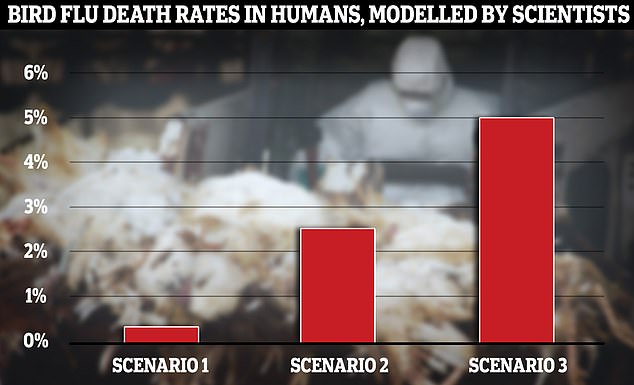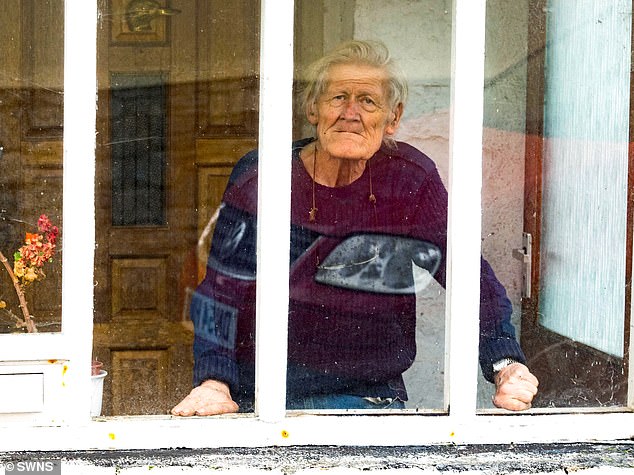Social distancing is back (but not in the way you might think!): Health bosses urge Brits to stay 2 meters away from ALL wild birds, including pigeons and seagulls, amid fears of bird flu pandemic
Britons must keep at least 2 meters away from wild birds, according to new government advice designed to thwart the risk of a new pandemic.
In their first-ever public guidance to help Brits ‘stay safe’, officials from the UK Health Security Agency (UKHSA) claimed that bird flu poses a ‘risk to human health’.
Bosses urged people to minimize their contact with all wild birds, including pigeons and seagulls.
Under the guidance, drawn up in partnership with the RSPCA and the Animal and Plant Health Agency, Britons are urged ‘not to handle or touch wild birds and their droppings’.
People should also always aim to keep a distance of ‘at least two metres’ ‘if possible’.
According to the UKHSA, more than 700 confirmed cases of H5N1 have been detected in wild birds in England since September 2022. Pictured above: An outbreak of bird flu last February in Queens Park, Heywood, Rochdale

British scientists tasked with developing ‘early human transmission scenarios’ of bird flu have warned that 5 percent of infected people could die if the virus spreads to humans (shown under scenario three). In another scenario, the scientists assumed that 1 percent of those infected would be hospitalized and 0.25 percent would die – similar to how deadly Covid was in the fall of 2021 (scenario one). The other saw a mortality rate of 2.5 percent (scenario two)
The UKHSA’s instructions come amid growing fears that bird flu could cause a new human pandemic.
There are no signs that the virus, which is believed to have killed millions of birds in Britain and infected poultry workers, can currently spread easily between people.
But experts have long feared that an outbreak of H5N1, with nearly 50 percent of people infected with it, is just around the corner.
It comes just a month after Beijing revealed the world’s first case of a new bird flu. A farmer in her 60s died after a two-week battle with the unprecedented H10N5 strain.
And last year, a Chinese woman became the first person to ever die from the H3N8 strain.
H5N1, which experts have identified as having pandemic potential in humans, has already fueled the world’s largest ever outbreak of bird flu.
More than 200 million domestic birds worldwide have been affected in recent years, along with countless wild birds, as well as mammals such as minks, foxes, raccoons and bears.
Experts fear the growing spread among species could cause the virus to pick up mutations that allow it to spread among humans.
The UKHSA’s advice to stay at least 2 meters away from wild birds was listed as a step for people who ‘need to handle’ the animals.
It also called on Britons to keep birds out, stating: ‘Do not bring it into your home or any enclosed area.’
Other guidelines include wearing clothing that prevents scratches or bite wounds, such as pants or long sleeves, and using masks, disposable gloves and eye protection.

Alan Gosling (pictured), a retired engineer in Devon, contracted the virus after his ducks, some of which lived in his home, became infected. No one else has contracted the virus
People are unlikely to contract bird flu from eating poultry and game birds because it is heat sensitive and cooking the poultry properly will kill the virus.
Common symptoms in humans include high fever, coughing, sore throat, muscle aches and a general feeling of malaise.
And like the common flu, it can quickly develop into severe respiratory illness and pneumonia.
Human infections occur when the virus gets into a person’s eyes, nose, or mouth or is inhaled.
Under the new guidelines, officials advised Britons to contact their regional health protection team if they have been in contact with confirmed or suspected cases of bird flu.
This may be by a healthcare or animal professional after a bird has been tested for the virus by a vet or DEFRA.
However, they warned that the risk to people remains very low and there is currently no evidence that it can spread more easily to people or between people.
Tthere have been only five cases of Britons becoming infected since the start of the current outbreak.
Retired engineer Alan Gosling – the first – contracted the virus in early 2022 after his ducks, some of which lived at his home in Devon, became infected.
